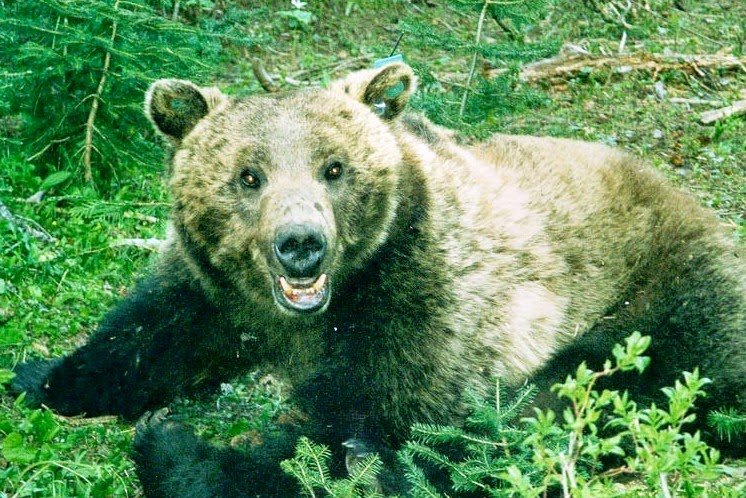Author’s note
 |
| Grizzly bear, Selkirk Mountains, Idaho |
Since 2012, I’ve been working with Keystone Conservation, a non-governmental organizaton which partners with land owners and managers to develop and apply solutions for holistic stewardship and coexistence with large carnivores–for thriving social and natural systems in the Northern Rockies. Years ago I worked to prevent and mitigate human-bear conflict for the National Park Service, and trapped and radio-collared grizzly bears for the Idaho Department of Fish & Game. In 2013 I moved to Montana to take everything I’d learned as a rangeland ecologist and ranch manager, and apply those same tools (that work for land health and livestock production) to preventing livestock predation in a region with the full suite of native carnivores: gray wolves, grizzly and black bears, and cougars. While livestock depredations are much less common than widely believed, they do happen and they are a significant source of mortality for carnivores, especially wolves and grizzlies. And for ranching to be truly resilient, it needs to prevent such conflicts as much as possible. I’m doing this work as Keystone’s Field Director for Rangeland Stewardship.
I wrote the article below on behalf of Keystone Conservation, in Holistic Management International‘s journal In Practice. This particular article is addressed primarily to ranchers and ranch managers, especially those who are holistic-thinking and conservation-oriented; and to the rangeland and wildlife conservationists who work with ranchers.
Introduction
From both ranching and conservation perspectives, livestock predation by large carnivores has traditionally been seen as a problem with the carnivores as its cause. For instance, much of the work done to reduce livestock-carnivore conflict has focused on keeping carnivores physically separated from humans and livestock, and on developing tools to manage the carnivores. A more holistic view is that carnivores are an inherent and valuable part of the system, some livestock predation is inevitable, and the root cause of excessive livestock predation is that conventional management has made livestock easier than wild prey for predators.
The weak link in carnivore conservation is lack of human tolerance, and the weak link in tolerance may well be conflicts with livestock. Habitat includes both the resources (for carnivores, prey) and the conditionsfor a species’ persistence. In the Northern Rockies, the large national parks and wilderness areas are relatively secure but insufficient habitat for large carnivores such as grizzly bears, wolves, and cougars. The working landscapes between these protected areas support prey animals, but may or may not be available habitat for carnivores, depending on human activities and tolerance. Although livestock-carnivore conflicts are a relatively minor source of livestock mortality overall, they can be locally significant, and they are a major concern for ranchers in the region, a major source of carnivore mortality, and of social polarization. Future gains in carnivore conservation will be largely on working landscapes.
We at Keystone Conservation believe that developing human tolerance for carnivores includes preventing or mitigating livestock depredations, and ideally occurs in the context of building both social and ecological resilience. This includes the ranching and broader conservation communities collaborating to improve rangeland health—the proper functioning of ecological processes—and thus the capacity of the land to produce biological diversity and ecosystem services, including forage for both wildlife and livestock. Ranchers generally seek a rural quality of life, with land-based livestock production. These utilitarian goals generally align with conservation goals, as they both rely on the same future resource base.
Overall, most carnivores are opportunistic, and most bears, wolves, and cougars remain focused on wild prey, even when livestock are nearby. But some individual predators do switch their focus to livestock, and if they do they are usually lethally controlled. Non-targeted lethal control is often ineffective at reducing livestock losses, because removal of individuals not focused on livestock opens up a place for other individuals that may be or become focused on livestock. We cannot expect to eliminate all depredations by preventing predators from switching from wild prey to livestock, but we may be able to keep them to a lower, opportunistic level.
The progressive livestock management practices often adopted by Holistic Management practitioners, especially planned grazing and low-stress herding, are partly based on the patterns of wild ungulate herds in the presence of their predators, and are an effort to partner with nature. These practices can improve rangeland health, livestock production, and ranch profitability. Because these practices are based on predator-prey relationships, ranchers can also use them to coexist with native carnivores.
To read the rest of the article, please see: (PDF at KeystoneConservation.US)
Please see also a previous article on the link between stocking density and preventing predation, on the front page of the Stockman GrassFarmer, by Becky Gillette, composed largely of quotes from me: (PDF at KeystoneConservation.US)
 |
| Electrified fladry is designed to deter wolves, but can also be used to contain cattle in temporary paddocks. Fladry works best for small areas and short times such as calving season. This calf was born in a fladry paddock on a summer grazing allotment. Photos by Garl Germann / The Rodear Initiative. |
 |
|
Matt Barnes using radiotelemetry to determine whether a radio-collared wolf is nearby before determining whether to set up a temporary paddock with fladry. Photo by Garl Germann / The Rodear Initiative.
|




